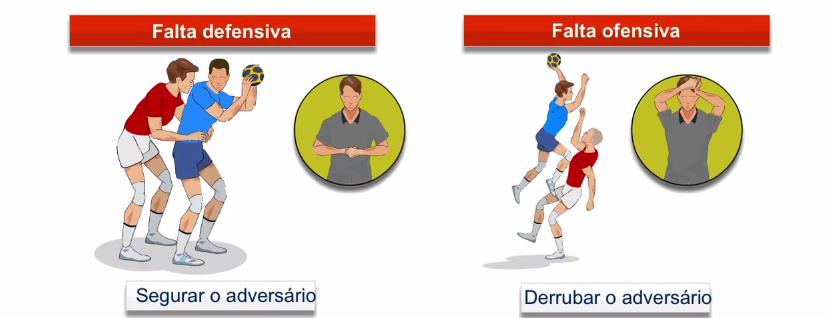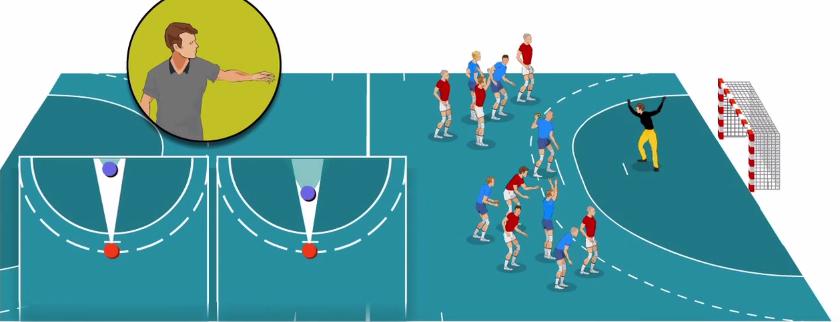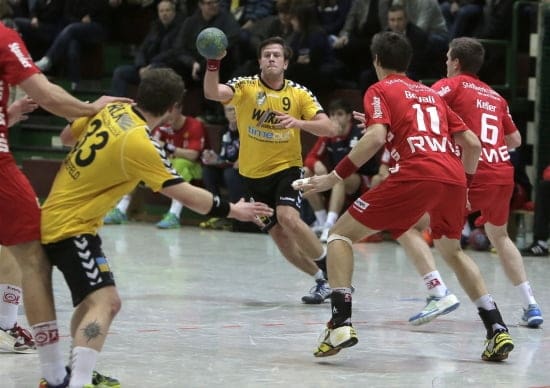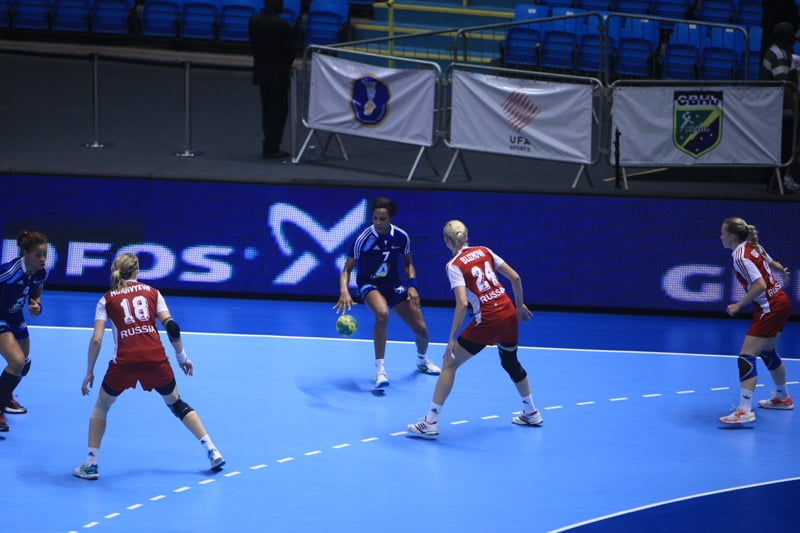The Main Rules of Handball
01 – What are the dimensions of the handball court?
The Handball is a rectangle measuring 20 meters wide by 40 meters long. The lines and markings on the handball court are: the goal area, free-throw line, goalkeeper limitation line, 7-meter line, substitution lines, center line, sideline and end line.
02 – How long does a HANDEBALL match last?
One of the basic rules of handball concerns the duration of a match. Handball. For players aged 16 or over, a match lasts two 30-minute halves with a 10-minute break. See the time of a Handball match for other categories:
- For players between 12 and 16 years the duration is two strokes of 25 minutes;
- For players between 8 and 12 years the duration is two strokes of 20 minutes;
- If extra time (overtime) is required, it is played in two 5-minute times each.
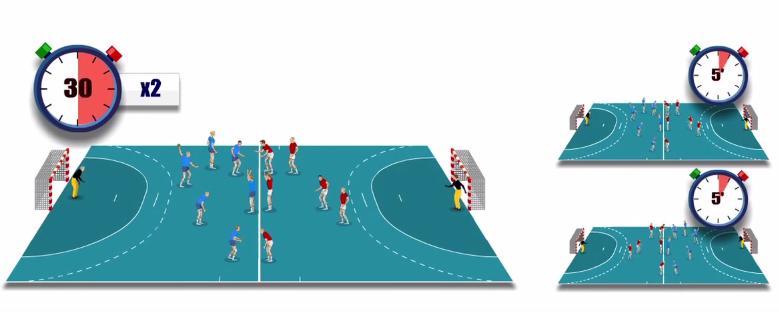
- Handball Rules and Fundamentals: time of a handball match
03 – What is the number of players in a handball team?
A handball team is made up of 7 players on the court and can have up to 7 substitutes. To start a match a team must have at least 5 players on the court.
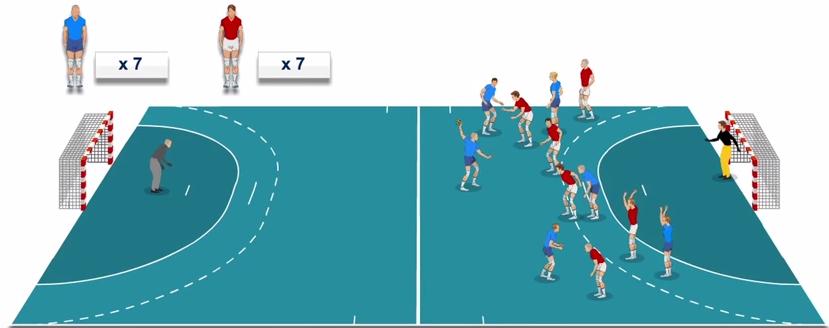
- Handball Rules and Fundamentals: number of players in a handball team
04 – How are substitutions made in handball?
According to the Handball Rules, substitutions are free, as long as they are made in the substitution zone and the substitute player only enters the court after the player being substituted has left.
05 – HANDEBALL GOALKEEPER is not allowed:
- Endangering the opponent in a defensive attempt
- Leaving the goal area with the ball in hand
- Touching the ball that is stationary or rolling on the ground outside the goal area, while he is inside the goal area
- Entering the goal area from the playing area with the ball under control
- Touching the ball with the foot or leg below the knee when it is moving out of the goal area
- Crossing the goalkeeper’s limitation line (4-meter line) before the ball has left the hand of an opponent taking a 7-meter shot
THE HANDEBALL GOALKEEPER CAN:
- Touching the ball with any part of their body, in an attempt to defend, inside the goal area
- Move with the ball inside the goal area
- Leave the goal area without the ball and, upon receiving the ball, take part in the game as a line player
06 – Invasion of the goal area in Handball
The goal area in handball is restricted to goalkeepers. When a line player enters the goal area, it will be scored:
- Goal kick, when a player from the attacking team enters the goal area with the ball or enters without the ball, but gains an advantage by entering
- Free kick, when a player from the defending team enters the goal area and gains an advantage,
- 7-meter throw, when a player from the defending team enters the goal area and prevents a clear chance of scoring
“It is not allowed to return the ball to the handball goalkeeper when he is inside his goal area. A free kick will be awarded to the opposing team.”
07 – HANDLING THE BALL IN HANDBALL:
- Throwing, catching, stopping, pushing or striking the ball using the hands (open or closed), arms, head, torso, thighs and knees is allowed.
- Hold the ball for a maximum of 3 seconds
- Take a maximum of 3 steps while holding the ball.
- Bounce the ball once and catch it again with one or two hands
- Bounce the ball repeatedly with one hand (dribbling) and then grab it again with one or both hands
- Roll the ball over the ground repeatedly with one hand and then grab it with one or both hands
08 – Fouls in handball:
- Snatching or striking the ball out of the opponent’s hands
- Pushing or blocking the opponent with arms, hands or legs or using any part of the body to dislocate them
- Grabbing an opponent, even if they remain free to continue playing
- Jumping or running over an opponent.
- Handball rules and fundamentals: fouls
09 – Shooting from the side in HANDBALL
- The throw-in is taken from where the ball left the court on the sideline
- The referee’s whistle (authorization) is not required for the execution of the throw-in.
- The player must keep one foot on the line during the throw-in.
- The opponents must respect a minimum distance of 3 meters from the taker of the throw-in, except when there is a throw-in from the side of the goal area and the opponent can position himself less than 3 meters away to remain outside the area.
10 – Goal Shooting in HANDBALL
According to the Handball Rules, the goal kick is taken only by the goalkeeper and there is no need for the referee’s whistle.
A goal kick is taken when:
- an opposing player invade the goal area
- the goalkeeper dominates the ball in his goal area or the ball is stopped within the goal area
- an opponent player touching the ball that is rolling or stopped within goal area
- the ball comes out the bottom line, after being touched by the goalkeeper or by an opponent
11 – The 7-METER SHOT IN HANDBALL
The 7-meter throw is one of the main official rules of handball and is awarded every time a clear chance of scoring is interrupted by a foul, an unjustified whistle, a person not taking part in the game or any official member of a team.
- Handball Rules and Fundamentals: 7-meter shot
- The 7-meter throw must be taken after the referee’s whistle, within 3 seconds and the ball must be thrown into the goal
- The shooter of the 7-meter shot must remain behind the 7-meter line
- after throwing the ball can not be played by running or a teammate of the same team until the ball touches an opponent or on the crossbar
- the player’s teammates must remain outside the free-throw line
- the opponents must remain outside the free-throw line and 3 meters away from the 7-meter line
- if the opposing goalkeeper crosses the goalkeeper’s limitation line and the goal has not been scored, the 7-meter throw must be repeated
basic rules of video football
For those who like video content, Dicas Educação Física recommends the video “Rules of the Game: Handball“, a great video on the Basic Rules of Handball available on Youtube.
Handball Fundamentals
Now let’s talk about Handball Fundamentals: execution of the technical fundamentals of Handball, characteristics and types of grip, passing, dribbling, throwing and feinting in Handball.
What is it and what are the Fundamentals of Handball?
Handball fundamentals are the techniques and movements used to play the game Handball. The main Handball Technical Fundamentals are: Handling, Reception, Passing, Throwing, Dribbling and Faking.
Wielding Bedding in Handball
The grip is one of the most basic handball fundamentals. It is the act of holding the handball with one hand. The correct grip in handball is made by holding the ball in the palm of the hand and pressing down (applying pressure) with the fingertips.
Execution tip: The pressure exerted by the thumb and little finger is very important for a good grip.
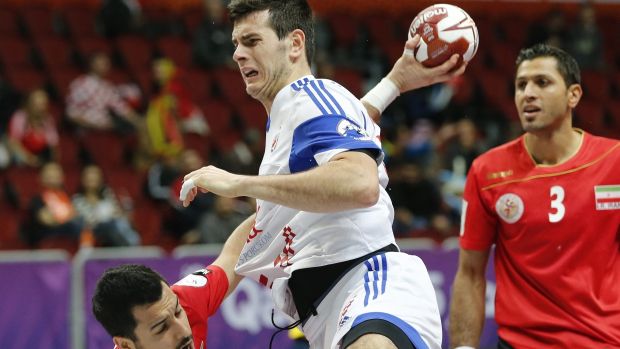
- Handball Rules and Fundamentals: The Handle
Foundation Reception in Handball
Reception is one of the simplest handball fundamentals. It is the act of receiving the ball. Reception in handball should always be done with both hands parallel and slightly concave (shell-shaped) and facing forward.
Note: The Reception in Handball can also be done with one hand.
Foundation Pass on Handball
Passing is one of the main fundamentals of handball. Passing is the act of throwing the ball between players on the same team.
- Handball Rules and Fundamentals: the Pass
What are the Pass Types in Handball?
- Over-the-shoulder pass: known as the shoulder pass, this is the most commonly used pass in a handball game and can be made in a straight or parabolic trajectory.
- Pronation pass: The Pronation Pass in Handball is made by holding the ball with the palm of the hand pointing downwards and rotating the wrist outwards. It can be done sideways or backwards.
- Behind-the-head pass: The behind-the-head pass in handball is executed exactly as the name implies, throwing the ball “behind the head”, and can be done in a lateral or diagonal direction.
- Behind-the-body pass: The behind-the-body pass is made by throwing the ball behind the body, it can be done in a lateral or diagonal direction.
- Back pass: This is a pass made at head height with an extension of the wrist, throwing the ball backwards.
- Bounced pass: This is when the ball touches the ground once before being received by the teammate. This type of pass is used to deflect the ball from a marked opponent.
FootIng Foundation in handball
The throw-in is also one of the main technical fundamentals of handball. It is through the throw-in that goals are scored in a handball match. The Pitch is the act of throwing the ball towards the goal (goal) of the opposing team.
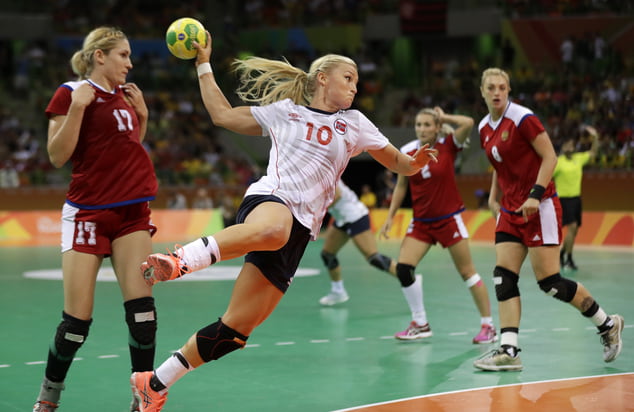
- Handball Rules and Fundamentals: the throw-in
What are the Types of Pitches in Handball?
- Supported throw – This is the type of throw in handball where one or both feet are in contact with the ground when the throw is executed.
- Suspended throw – In this type of throw, the handball player jumps and is completely suspended in the air when the throw is executed.
- Falling throw – This is the type of throw in handball where the player projects a fall after the throw. By forcing a fall, the handball player projects their body and is able to put more power into the throw. It’s a kind of pitch widely used among the pivots in Handball.
- Rolling throw – This is the type of throw where, after the player has thrown the ball, he rolls it, usually with his shoulder. It is a type of pitch commonly used by the “Tips” in Handball.
Dribbling Bedding in Handball
Dribbling is a basic skill in handball, the act of bouncing the ball with one hand without losing control of the ball. Dribbling can be done with the player standing or moving. The main function of dribbling in handball is to progress with possession of the ball.
- Handball Rules and Fundamentals: Dribbling
What are the types of Dribble in Handball?
The High Dribble: This is often used to move the handball player at speed. The high dribble is often used in counter-attacks.
The Low Dribble: The low dribble is basically used to protect the ball in front of an opponent’s marker.
The goals of Dribbling in Handball are:
- outwit the defense
- get out of the way
- gain a more favorable pitching position
Finite Bedding in Handball
The feint in handball is performed when a player in possession of the ball threatens to move in a certain direction in order to deceive and unbalance the opponent’s marking and move in another direction.
Are Finta Technical Characteristics in Handball
- Movement (moving from one point to another on the court)
- Change of direction (moving in different directions)
- Rhythm change (from slow to fast and from fast to slow)
What are the Feint Goals in Handball?
- Getting past an opponent
- Unbalance a direct opponent
- Divert the opponent’s attention
- Gaining numerical superiority over the opposing team
They are features for a good Feint:
- Have a good reaction speed
- Having a ball travel speed
- Having a good balance
- Being agile when changing direction
What are the Feint Types in Handball?
- Pitch Feint
- Pass Finta
- Finta with shift to the right
- Finta with left shift
More about Handball
- VIDEO: Handball Rules and Fundamentals
- The Official Handball Court
- Origin and History of Handball
- Official Handball Rules
- Basic Rules of Handball
- Video lesson History of Handball
- Handball Game Systems
- How to Teach Handball
- Passive Play in Handball
- Side Shot in Handball
